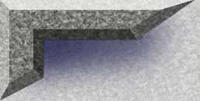Wreck of the Royal Charter
By James Donahue
The hurricane that drove the steam clipper ship Royal Charter to its destruction on the Welch coast
in October, 1859, killing 459 passengers and crew members claimed yet another 200 ships. But because of the nature of the
disaster, the storm went down in local history books as the Royal Charter Gale.
The 320-foot iron hulled ship was launched in 1855. She was a clipper ship, a popular design built
for speed in its day, but equipped with auxiliary steam engines for use when the wind wasn’t blowing favorably. The
vessel was especially designed for passenger service with room for up to 600, plus there was room below decks for cargo. It
was put on a route from Liverpool to Australia.
In late October, 1859, the Royal Charter, under command of Captain Thomas Taylor, was returning to
Liverpool from Melbourne with 371 passengers and a crew of about 112, when the storm struck when the vessel was on the last
stage of its journey off Holyhead in the Irish Sea.
The wind grew in strength until hitting strength of over 100 miles per hour out of the North-Northeast.
The winds and the pounding seas drove the Royal Charter closer and closer to the north coast of Anglesey. The crew dropped
anchors and used its engines to fight the storm, but the anchor chains parted and the engines lacked the strength to make
any headway. Captain Taylor even ordered the masts and sails cut down in an effort to save his ship. But the storm eventually
drove it on the rocks where the ship broke up.
As the story is told, one member of the crew, known as Joseph Rogers, successfully swam ashore with
a line and successfully used a boatswain’s chair to rescue 21 passengers and 18 crew members. All were men. This effort
was halted as the ship began to break up. These man were the only survivors. The others perished attempting to swim to shore,
many of them weighted down by belts of gold they were bringing with them from Australia.
There was reportedly a lot of gold on the Royal Charter when it wrecked. The bullion was insured for
322,000 pounds but some believe there was much more gold being privately carried by passengers or stored in the ship’s
vault. Stories were told of how residents along the beach at Porth Alerth became rich overnight by recovering the gold found
on the beach and in the wreckage.
Many of the bodies recovered from the site were buried at St. Gallgo’s Church, Llanallgo, which
is close to the wreck site. A memorial still stands at the gravesite.
Sport divers still search the old iron wreckage searching for some of the gold believed to still be
lying at the bottom of the sea.

